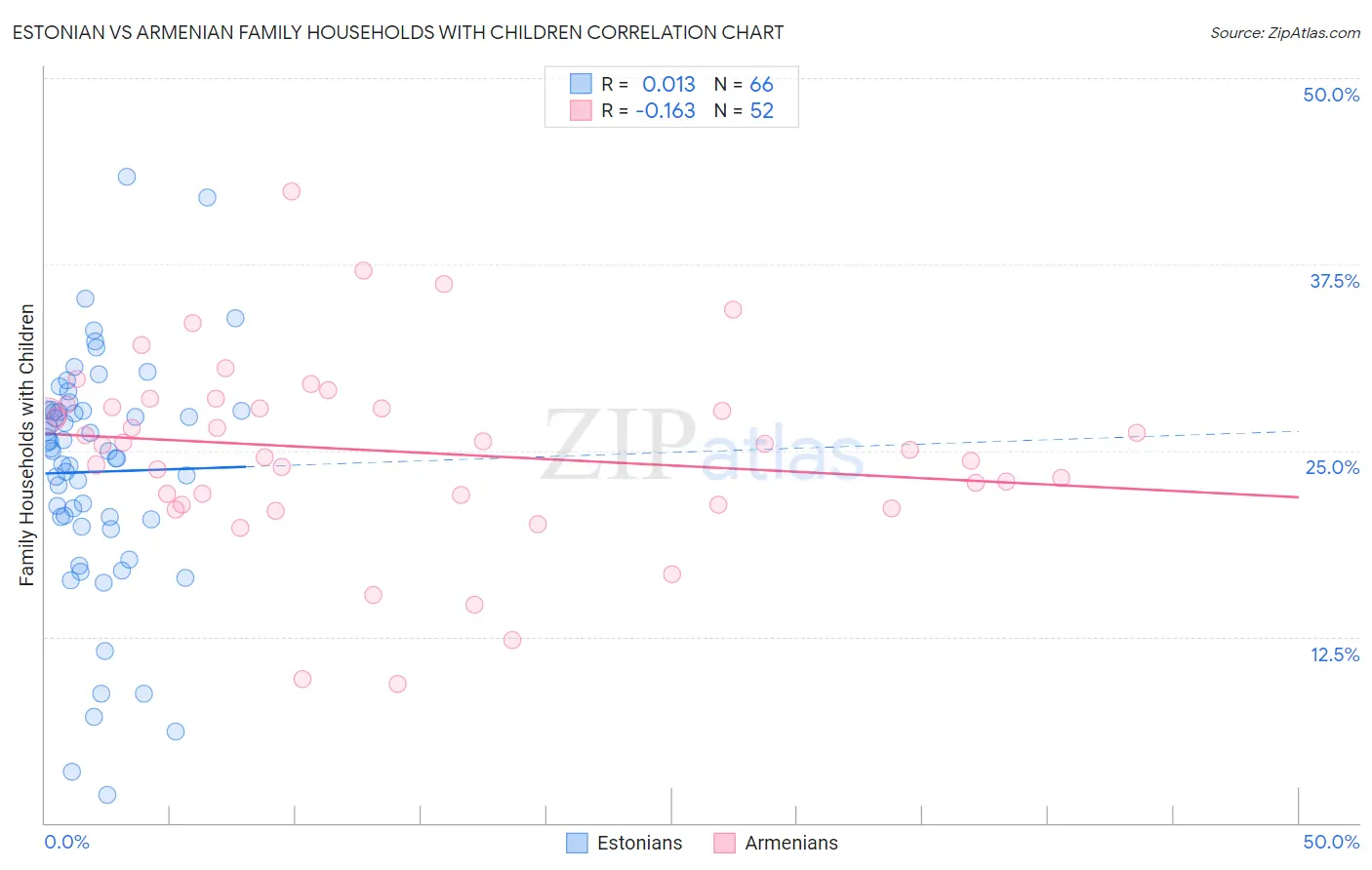Estonian vs Armenian Family Households with Children
COMPARE
Estonian
Armenian
Family Households with Children
Family Households with Children Comparison
Estonians
Armenians
26.1%
FAMILY HOUSEHOLDS WITH CHILDREN
0.0/ 100
METRIC RATING
316th/ 347
METRIC RANK
26.4%
FAMILY HOUSEHOLDS WITH CHILDREN
0.1/ 100
METRIC RATING
297th/ 347
METRIC RANK
Estonian vs Armenian Family Households with Children Correlation Chart
The statistical analysis conducted on geographies consisting of 123,477,071 people shows no correlation between the proportion of Estonians and percentage of family households with children in the United States with a correlation coefficient (R) of 0.013 and weighted average of 26.1%. Similarly, the statistical analysis conducted on geographies consisting of 310,641,261 people shows a poor negative correlation between the proportion of Armenians and percentage of family households with children in the United States with a correlation coefficient (R) of -0.163 and weighted average of 26.4%, a difference of 1.3%.

Family Households with Children Correlation Summary
| Measurement | Estonian | Armenian |
| Minimum | 1.9% | 9.3% |
| Maximum | 43.3% | 42.4% |
| Range | 41.4% | 33.1% |
| Mean | 23.6% | 24.9% |
| Median | 25.0% | 25.4% |
| Interquartile 25% (IQ1) | 20.4% | 21.7% |
| Interquartile 75% (IQ3) | 27.7% | 28.0% |
| Interquartile Range (IQR) | 7.3% | 6.3% |
| Standard Deviation (Sample) | 8.0% | 6.3% |
| Standard Deviation (Population) | 7.9% | 6.3% |
Demographics Similar to Estonians and Armenians by Family Households with Children
In terms of family households with children, the demographic groups most similar to Estonians are Immigrants from Norway (26.1%, a difference of 0.080%), French Canadian (26.1%, a difference of 0.15%), Cree (26.2%, a difference of 0.23%), Immigrants from Czechoslovakia (26.2%, a difference of 0.49%), and Colville (26.2%, a difference of 0.56%). Similarly, the demographic groups most similar to Armenians are Croatian (26.4%, a difference of 0.010%), Immigrants from Western Europe (26.4%, a difference of 0.10%), Trinidadian and Tobagonian (26.4%, a difference of 0.11%), Paiute (26.4%, a difference of 0.23%), and Immigrants from Trinidad and Tobago (26.4%, a difference of 0.25%).
| Demographics | Rating | Rank | Family Households with Children |
| Croatians | 0.1 /100 | #296 | Tragic 26.4% |
| Armenians | 0.1 /100 | #297 | Tragic 26.4% |
| Immigrants | Western Europe | 0.1 /100 | #298 | Tragic 26.4% |
| Trinidadians and Tobagonians | 0.1 /100 | #299 | Tragic 26.4% |
| Paiute | 0.1 /100 | #300 | Tragic 26.4% |
| Immigrants | Trinidad and Tobago | 0.1 /100 | #301 | Tragic 26.4% |
| Serbians | 0.1 /100 | #302 | Tragic 26.4% |
| Immigrants | Guyana | 0.1 /100 | #303 | Tragic 26.3% |
| Immigrants | Bahamas | 0.1 /100 | #304 | Tragic 26.3% |
| Guyanese | 0.1 /100 | #305 | Tragic 26.3% |
| Bermudans | 0.1 /100 | #306 | Tragic 26.3% |
| West Indians | 0.0 /100 | #307 | Tragic 26.3% |
| Lumbee | 0.0 /100 | #308 | Tragic 26.3% |
| Immigrants | Somalia | 0.0 /100 | #309 | Tragic 26.3% |
| Marshallese | 0.0 /100 | #310 | Tragic 26.2% |
| Colville | 0.0 /100 | #311 | Tragic 26.2% |
| Immigrants | Czechoslovakia | 0.0 /100 | #312 | Tragic 26.2% |
| Cree | 0.0 /100 | #313 | Tragic 26.2% |
| French Canadians | 0.0 /100 | #314 | Tragic 26.1% |
| Immigrants | Norway | 0.0 /100 | #315 | Tragic 26.1% |
| Estonians | 0.0 /100 | #316 | Tragic 26.1% |